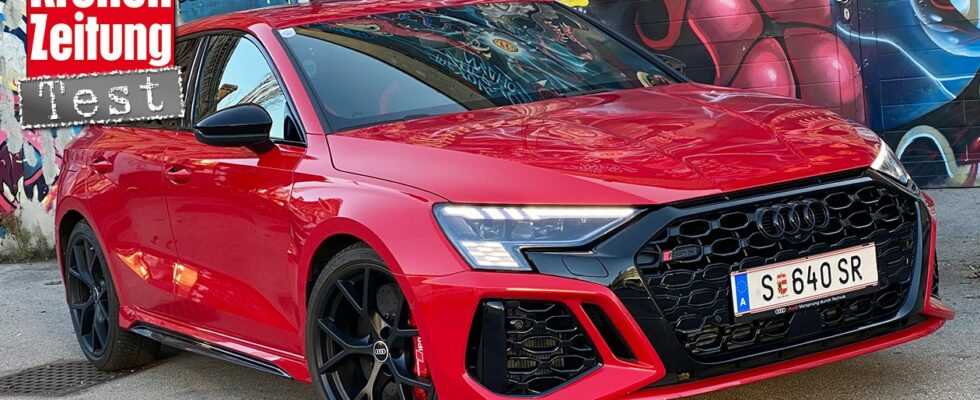It’s always said that you should stop when it’s most beautiful. That is hardly the reason why the Audi RS3 is unlikely to get another one with a five-cylinder engine in the current one. In fact, he’s better than ever. “Krone” motor editor was on the road with the compact joy dispenser. His driving impressions here in the video! The choice of the title is also explained there…
Cars of the caliber of an RS3 are not only bought because of the engine performance, but above all because of their character. And in the case of the Ingolstadt resident, this is particularly shaped by his engine. Where BMW caresses the ears with six cylinders, the five in the Audi give a real roar to the ears. Pleasant, but intense. Maybe also intense, but euphonious. Everyone has to make this fine distinction for themselves. The flap exhaust is standard on board, but the test car is equipped with the RS sports exhaust system for 1300 euros. The impressive engine sound results on the one hand from the special ignition sequence (1-2-4-5-3, ie directly adjacent cylinders and those further apart from each other fire alternately), on the other hand from the artificial sound played over the loudspeakers. Fortunately, this doesn’t look synthetic. Full pipe to your ears The engine is basically an old friend, it’s the 2.5 TFSI with dual injection, i.e. intake manifold and direct injection. In its current version, it presents its 400 hp earlier and longer than its predecessor (5600 to 7000 rpm), the maximum torque is now a smooth 500 Nm, ie 20 Nm more than before. In addition, the torque curve is more favorable. The speed plateau begins at 2250 tours, says Audi. In reality, however, full propulsion only starts at around 3000 rpm. With a sporty driving style, this hardly matters, in everyday life it seems a bit inharmonious, especially in connection with the seven-speed double-clutch transmission, which sometimes acts quite rough. The maximum speed in the Audi RS3 depends on the price. Depending on the equipment, it is limited to 250, 280 or 290 km/h. The standard sprint time is given as 3.8 seconds. In the test with winter tires, we even managed 3.6 seconds in some cases. Record on the Nordschleife All impressive values. But – assuming a practiced hand – they can also be converted into real speed: The Audi RS3 is considered the fastest compact car on the Nordschleife. 7:40.748 minutes, with the optional semi-slicks, which are available ex works for the first time in the RS3. Like the standard tires, they are larger at the front than at the rear: 265 in the front, 245 in the rear, each on 19-inch aluminum. The front wheels carry 59 percent of the weight. In the basic state, that is 1570 kilograms without a driver. Significantly tighter than the Audi A3/S3 The body of the Audi RS3 makes it clear at first glance that this is a sports model. , especially the fender flares wear thick. Not without reason, however: the track is 33 millimeters wider at the front than on the civilian A3 and S3, and the wide tires also have to fit into it. The RS3 is one centimeter lower than the S3 and 2.5 centimeters lower than the A3. The test car’s adaptive dampers cost extra. The brake system is new and now has larger (375 mm), thicker discs, larger pads and improved cooling as standard. Optionally, 380 mm ceramic discs with red six-piston calipers are available for a good 6500 euros. Not only are the brakes better than they used to be, the standard progressive steering works very sensitively and directly. Elaborate all-wheel drive The all-wheel drive is also new. It now has a so-called torque splitter. It consists of two multi-plate clutches, i.e. one for each rear wheel, which variably distribute the power going to the rear. In extreme cases, the outer rear wheel gets the full power. Depending on the driving mode and driving style, the torque splitter simply minimizes understeer or turns the RS3 into a drift artist – in the “Torque Rear” driving mode. Discreetly sporty interior The interior is also sporty. Red accents, high-quality materials, at least in the clearly visible area, red accents. A highlight is the handy Alcantara steering wheel, whose controls are real buttons and rollers. The RS button, which activates the two sporty driving modes RS Individual and RS Performance, is new here. It’s not as “sexy” as the M buttons in a BMW, but still. A total of seven driving modes can be called up via the display. Different views can be set on the speedometer, and there is also an automatic timer for sprints. The price The basic price for the Audi RS3 Sportback is 73,073 euros. The test car comes to over 101,000 euros. Including extras worth 28,000 euros, not all of which you need, but some, such as MMI navigation, RS dynamic package plus or matrix headlights. You save the most by leaving out the carbon-ceramic brakes. Fahrzit: It’s a shame that this is the last trip for the Audi RS3. Five-cylinders will hardly be among the combustion engines that survive the longest. In any case, you could say that they finished developing the RS3 for his farewell tour. Technically and in terms of driving dynamics, it is absolutely up-to-date. Not politically.Why?The sound!Top all-wheel driveReally fastWhy not?Not for sensitive earsOr maybe……Mercedes-AMG A45, BMW M2 (when it comes)
source site-13
